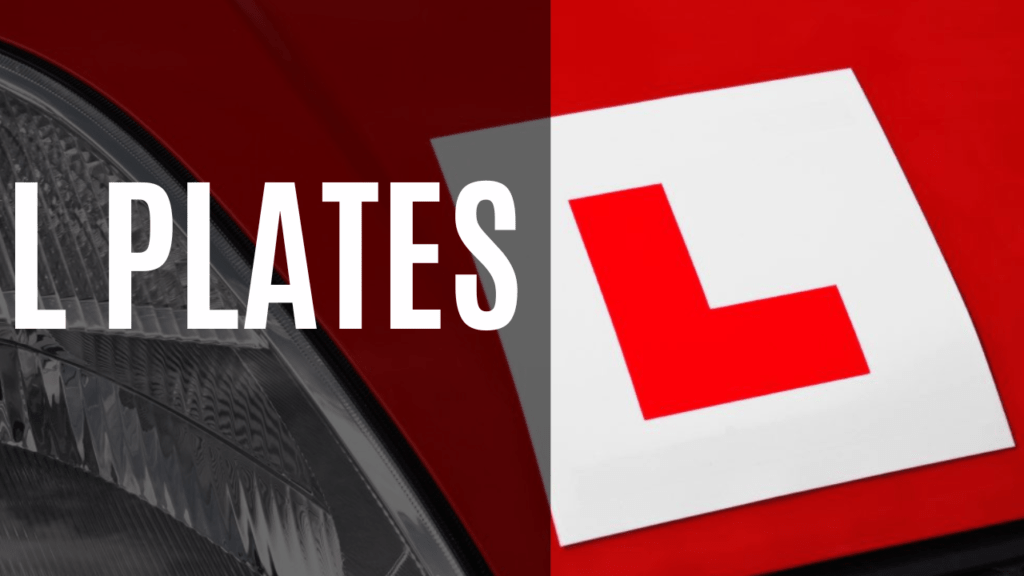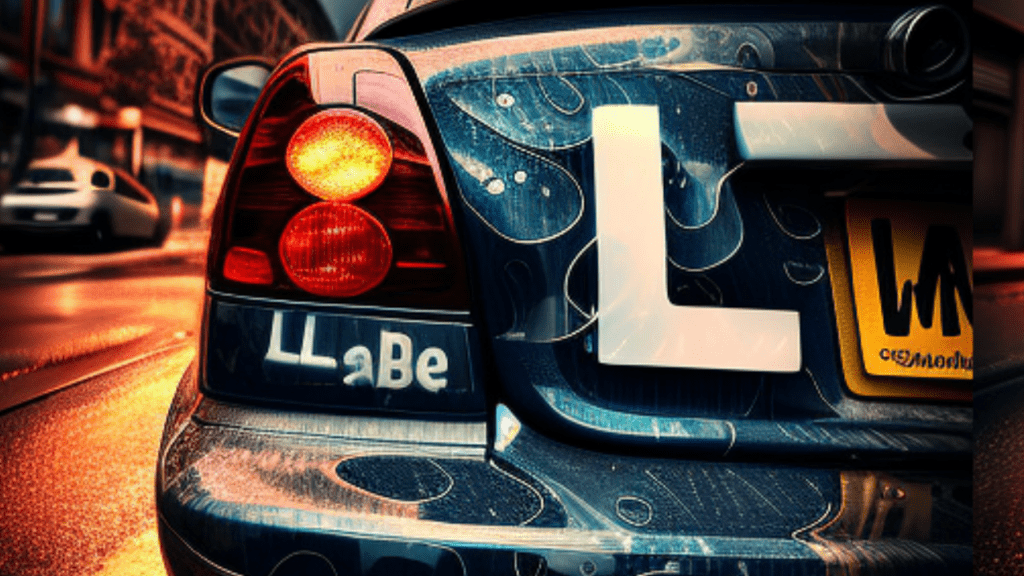IF you are reading this im guessing you are heading for that journey to learn to drive. But you want to double check the latest L Plate Rules when you are Learning to Drive. You have most likely seen cars with red L’s on the front and back, the L plates. They are used on any car that a learner is driving to let other vehicles know that it is a learner driving, not an experienced driver. This allows other vehicles to give the learners more room to react to situations as well as giving you, the learner, more time to react to unpredictable maneuvers from them. Read on for everything you need to know about L plates.

L Plate Rules when you are Learning to Drive – Do you have to use L plates on the car ?
The short answer is YES!
The long answer is having a regulation-size L plate on the front and back of your car whilst you are driving is a legal requirement. These must be clearly shown and visible for any other vehicle to see.
If you do not have L plates on your car and are pulled over by the police you can receive anything from a warning up to £100 fine and 3 points on a license you do not yet have. When a learner is not driving, the L plates should be removed or covered. The only exception to this is Driving schools and Instructors.
Why Do My Sticky L Plates Keep Falling Off?
- Poor quality Glue: The adhesive on the plates will break down over time and will need to be replaced. This will happen faster in poor weather such as heavy rain.
- Dirty surface: Before you put the “L” plates on your car, make sure the surface is clean and dry. Dust, dirt, or moisture can prevent the adhesive from sticking properly.
- Applying improperly: If you’re using suction cup “L” plates, they may not adhere correctly if not applied properly. Ensure the surface is clean, and moisten the suction cup slightly before sticking it on.
- Plate quality: Some “L” plates are simply made from cheaper materials that don’t hold up as well. Investing in higher quality plates could solve the problem.
The best way around this is to use magnetic L plates where possible. You could also consider using magnetic L plates if your vehicle has a metal body. They are easy to put on and take off, and you don’t have to worry about them falling off as long as the surface is clean and the plates are positioned correctly. However, be aware that these might not work if your car has a non-magnetic body, such as aluminium or fiberglass.
Why Do My Magnetic L Plates Keep Falling Off?
If your magnetic L plates are falling off, there might be several reasons:
- Non-Metallic Surface: Magnetic plates require a metallic surface to stick. If you’re trying to place them on a non-metallic part of the car (for example, if your car’s body is made of aluminum, plastic or fiberglass), the plates won’t stick.
- Curved or Uneven Surface: Magnetic plates work best on flat surfaces. If your car’s bodywork is highly curved or uneven, the magnet may not make full contact with the surface and may be more likely to fall off. Magnetic L Plates often struggle on the back of Ford Focuses for exmaple due to the curve of the boot. The best way aorund this is using a sticky L plate in the rear window instead.
- Dirty or Wet Surface: Similar to adhesive plates, the surface where you’re trying to apply the magnetic plates should be clean and dry. Dust, dirt, or moisture can create a barrier between the magnet and the car, preventing the plates from sticking properly.
- Weak Magnet: Not all magnetic plates are created equal. Some might not have strong enough magnets to withstand high speeds or bumpy roads.
- Plate Placement: If the plates are near the edge of the car, they may be more exposed to wind force, which could peel them off while driving.
- Poor Quality Plates: If the plates are made of poor quality materials, they may warp or degrade over time, causing the magnet to lose its sticking power.
The best way to avoid these issues above is to buy thicker magnetic L plates. Basically buy some good ones as they say you get what you pay for.
Where should I Put L Plates on the Car?
L plates must be highly visible on the front and rear of the vehicle. There is nothing saying exactly where they should be. It is not advised to place the L plates on either the front or back windows as it will reduce the driver’s visibility, on either bumper as it will be difficult to see by other vehicles, or on the front grill as it will most likely fall off due to airflow. Use your common sense and make sure it is obvious for other vehicles so you do not get a fine or points on your soon-to-be driving license.
If you are looking for advice with teaching your teen check out our latest blog on How to Teach Your Teen to Drive.
L Plates on your Personal Car for learning

Some learners like to use their own cars for their driving tests. If you do this make sure your L plates are showing clearly and in good condition as the test taker has the discretion to reject a car if they are not. It is also advised you keep a spare set in your car at all times in case either plate falls off.
Looking for some extra support with teaching your teen?
FAQ
1. What does an L plate signify in the UK?
An L plate in the UK indicates that the person driving the vehicle is a learner driver. These plates are designed to notify other road users that the driver is still in the process of learning and might not be fully competent in all aspects of driving.
2. Are L plates mandatory for learner drivers in the UK?
Yes, L plates are mandatory for all learner drivers in the UK. They must be displayed prominently on the front and rear of the vehicle whenever the learner is driving. You should however not have L plates on the car if you are not currently teaching someone to drive.
3. What are the size requirements for L plates in the UK?
The official size for L plates in the UK is 178mm x 178mm. The letter “L” on the plate should be red on a white background.
4. Can I drive alone if I’m a learner driver?
No, learner drivers are not permitted to drive alone. They must be accompanied by a qualified driver who is over 21 and has held (and still holds) a full driver’s licence for the same type of vehicle for at least three years.
5. Can a learner driver carry passengers?
Yes, a learner driver can carry passengers in the car as long as the qualified supervising driver is present. The supervising driver takes legal responsibility for the vehicle, so the number of passengers must not exceed the number of available seats and seatbelts.
6. Where should L plates be placed on the vehicle?
L plates should be placed on the front and back of the vehicle. They need to be easily visible, not faded or dirty, and must not obstruct the driver’s view.
7. What happens if I don’t display L plates as a learner driver?
If a learner driver doesn’t display L plates while driving, they can face a fine, penalty points on their provisional license, and potentially a court order preventing them from driving until they pass their test.
8. When should I remove my L plates?
L plates should be removed as soon as the driver has passed their driving test and holds a full driving license. It’s illegal to display L plates if you’re not a learner driver.
9. Can I drive on motorways with L plates?
Since 2018, learner drivers in the UK have been allowed to drive on motorways if they are accompanied by an approved driving instructor (ADI) and driving a car fitted with dual controls. If you are not with an approved driving instructor then you cannot go on a motorway.
10. Are there alternatives to L plates?
Yes, in Wales, you can use a D plate (D for Dysgwr, the Welsh word for Learner) instead of an L plate. The rules for D plates are the same as those for L plates.




Leave a Reply